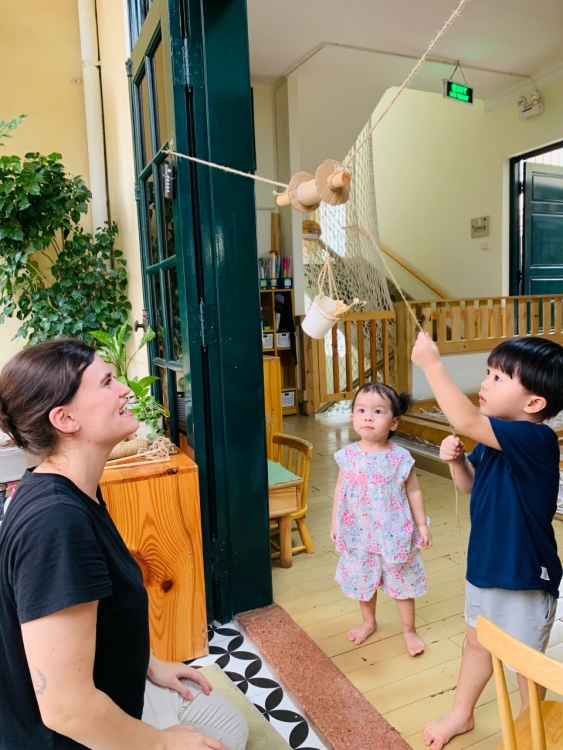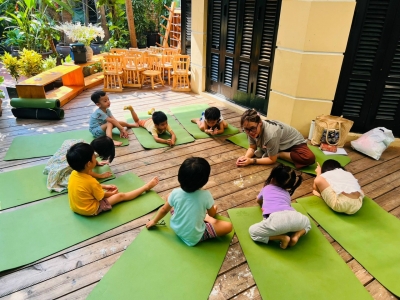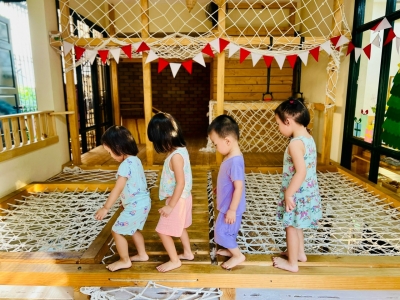HELPING CHILDREN TO DO THINGS BY THEMSELVES
Montessori kindergartens are called Children's Houses. Our concept of a school is not just a building with four walls to contain children, but a place where the children themselves are the hosts. This concept speaks to the necessity of preparing a place specifically for children, where they can engage in activities that suit their physical and intellectual needs. The teacher should act as a guest or as someone who comes to assist the children.
One of the first ideas Dr. Montessori had when she started her work in child education was that the furniture should be child-sized. This idea may seem commonplace to us now, but when it was first implemented over 100 years ago, it astonished everyone.
At the same time, Professor John Dewey of Columbia University in New York, a distinguished philosopher, psychologist, and educator of the 20th century, decided to find child-sized furnishings such as tables, chairs, and cabinets but could not find any. He then expressed his view in a now-famous statement: "In terms of the physical environment, the world has forgotten about children."
This observation was indeed accurate. However, when Dr. Montessori began her work in child education, she stated: "If children's houses do not exist, let us build them. If the necessary items for children have not been made, let us create them." Everything that was made and how it was made was tested and experimented with. Moreover, not only were the furnishings and equipment child-sized, but many other things conducive to children's development were created.
Ideas are foundational, and often a simple idea can lead to wonderful results. The outcome of this idea was not only that children could serve themselves using these items, but most importantly, their temperaments changed thanks to using them. Children exhibited excitement when working with these items, an excitement that was very different from the excitement they showed when playing.
Thus, a new approach was born. An approach that always considers the special needs of children's psychological and physical development. This is also the solution to the problem of children's freedom, as well as to their behavior and conduct. Now we will talk about some details of these issues.

Mothers often say: "My child drives me crazy," "He is so hot-tempered," "My child always clings to me," "I can't leave him for a moment," "My child gets bored easily." Other mothers might say, "Oh, my child is so boring," or "He always wants to tell stories or asks about everything." These are behavioral issues.
There are also issues regarding conduct, as parents often say: "My child is so naughty, how can I make him behave?" or "What should we do with him, he's so rebellious, should we spank him?" In one way or another, children create many problems both at home and at school.
The core issue here is the problem of children's freedom. We face the difference between a democratic (free) regime and an authoritarian (submissive) regime. Should children be free to shape their character, or should they be molded by others to have character? The issue of children's freedom is as urgent as the issue of national freedom.
Today, many believe that children should be free. Therefore, these families face the problem of how to give children freedom. Giving children freedom is not just about solving one problem, but it relates to many other challenging issues.
That is why people were so excited when the Children's House was established. It provided a solution. Adults had failed to understand the physical and intellectual developmental needs of children. And another failure was providing the necessary activities for children's development. The Children's House is the answer.
Let us look back at what happened in households where adults were the hosts. Let us look back 100 years, when the science of childhood or the natural laws of child development were ignored. Loving mothers took care of their children meticulously, bathing them, drying them, applying powder, dressing them, combing their hair, carrying them for walks, and attending to their every physical need.
Consider the mother whose child is climbing onto a chair or sofa, who says sternly, "Get down now!" or another mother in the same situation who says gently, "Sweetie, come down, please." Each mother has her way of disciplining her child.
And as you might imagine, whether the mother uses an angry or gentle tone, it is the same to the child, because the core issue for both mothers is the same. Both the angry and the gentle mother are preventing their child from doing what they are doing. If the child wants to sit on a step, they are immediately told, "Oh, don't sit there, it's dirty." Whether the prohibition is sweet or angry, it is still a prohibition.
If you think about the issue of preventing children from doing things that, from an adult's perspective, they should not do, you will realize that this child is in a situation not unlike the beggars in London who are looking for a place to sleep. First, they try the church, and the caretaker tells them to leave. Then they go to the park to find a bench, but the guard also drives them away. Finally, they are forced to wander the streets all night, not allowed to sleep anywhere.
Children are similarly not allowed to use anything around them in the adult's space. "Don't touch..." is the basic command they receive regarding fragile or valuable items or items the adults use in the house, such as porcelain cups, clocks, pens, and other fragile things. Overall, children are not allowed to use any practical items in the adult's space.
Children will be given a rubber ball or some plastic toys and told, "Play with these." But soon they will throw them away. It doesn't matter that the child might also have a reason to complain, but the parents will be the ones to complain, saying, "Whenever I give him toys, he breaks or throws them away." The sad thing about this adult attitude is the imposition, which the child feels as a hindrance to their every effort to be active. At this point, the child's drive for physical and mental activities is thwarted; they suffer the torment of being suppressed in every move they make.
Although mothers or caregivers may not be consciously aware that they continuously suppress children, it is a fact. They are either unaware of or ignoring the child's desire to use their senses and limbs, their efforts to understand their surroundings, to engage their intellect with the objects around them, and to gain knowledge directly from those objects.
Another serious issue is unnecessary assistance for children. These helps are actually hindrances. All good mothers want to dress their children, comb their hair, carry them for walks, and do all sorts of things for them. Some mothers even say, "Our responsibility is to do everything for our children. The more a mother can do for her child, the better." We wish to state this sooner: every unnecessary help is an obstacle to a child's development.
There was once a mother, admired by many, who said, "I will bathe my children myself every day until they are 12 years old." At that time, people did not realize that just meeting a child's physical needs was not enough. The most important need is to help the child do things by themselves. Children have a need for independence, and such help does not contribute to this need. Independence is essential for a child's growth and development.
Kindness from adults in this manner becomes a danger to the child. Because the child will grow up showing a lack of ability and independence. We must provide support for the child's development, not hinder it.
------
Source: The Montessori Series: What You Should Know About Your Child - Helping the Child to Help Himself
Translate: Hà Ly Nguyễn (Guide AMI 3-6)
Photos
Others


















